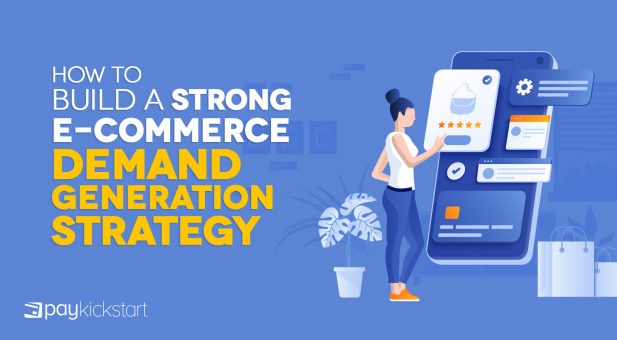Subscription growth hack (by PayKickstart)
Facebook Group - 3,932 members
Visit Group
The start is never easy. Considering how big competition in e-Commerce is, the start is as hard as ever. In fact, 46% of global-wide companies believe that the competition is very tough.
There are just too many businesses that offer the same services or products and were there before you. Therefore, marketing experts have come up with many ways that help you to catch the attention of your audience.
One of those methods is demand marketing. In this article, you will learn what demand marketing means, why you shouldn’t confuse it with lead generation and inbound marketing and how to develop a strong e-Commerce demand generation strategy.
The start will still be hard but at least you will have the plan that gets you to success faster!

Source: https://unsplash.com/@servuspaul
Demand generation is combined marketing and sales team efforts that aim at creating buzz around a product and brand, find and nurture high-fit prospects and create long-term relationships with the target audience. Demand generation involves a lot of processes and methods and sends customers down quite a lengthy sales funnel. It results in more time spent on each prospect but more loyal customers.
The success of demand generation is not measured in the number of leads but in their contribution to the revenue. In the end, the sales team has a prospect that is already extremely interested in the brand.
It is also important to highlight the problems of the future customers that they may have but still do not know about. Then you have to prove that the problem is urgent enough, so they would contact you for a solution.
Marketers sometimes confuse demand generation with lead generation and inbound marketing. They even use inbound marketing and demand generation interchangeably. Yet, these three words are very different and the difference does matter if you want to build a strategy for demand generation specifically.
Firstly, let’s draw a line between the two approaches: demand generation and inbound marketing. Simply put, inbound marketing is a solid part of demand generation. You have to create high-quality educational content to raise awareness about your business and inbound marketing successfully serves this purpose. However, demand generation has other tools like PR, events and webinars, account-based marketing, etc.
The main difference between lead generation and demand generation is a bit harder to spot. While demand generation focuses on raising awareness, lead generation focuses on capturing leads. There is no need to actually convert users into paying customers in demand generation while leads have to give their emails or do other favorable action. In demand generation, you want customers to come to you on their own and in lead generation, you will have to still make them interested in your brand.
Now that we fully understand the concept and aims of demand generation and how it differs from any other marketing strategy, we should learn how to develop an e-commerce strategy that will help your business grow.
There is not much sense in creating the strategy if you do not have clear goals. It will not be a strategy anymore but random marketing acts.
In order to have a steady growth in demand generation, you have to set goals that are realistic, yet not too easy. These goals will be a baseline and you can build and optimize your strategy around them. If you have a clear vision of what you want, it will be easier to find the tools that will help you to achieve that.
Moreover, goals will motivate you and your team in demand generation, especially when you notice that you have started to achieve them.
Defining buyer personas and buyer’s journey is a basic step in building any marketing strategy.
A buyer persona is a person who is more likely to buy the product. However, you can not just create one persona. More often than not, the marketing and sales teams develop different buyer profiles. For example, your customer needs, pains, problems will differ, depending on their demographics, lifestyle, position, etc. The process of creating different profiles is called segmentation.
After you have your buyer personas, you need to establish a customer journey for every profile. A business has to define all the touchpoints and buyer’s reactions and behavior during different stages of a journey.

Source: https://unsplash.com/@alexisrbrown
If you know your personas and their pains, you will know what content to deliver. If you know the buyer’s journey, you will know what is the right time to show this content.
Content is a great way for a brand to gain a thought leader, to attract attention to customer pains and problems, and to explain more clearly how your company can help. Around 85% of companies have a content marketing strategy that demonstrates how popular it is. Considering that content costs 62% than any other marketing effort while generating 3 times more leads, it is obvious why.
Even though blog posts are one of the most popular content formats, there is much more to that. Content is also:
Combine different types of content and distribute them on different channels to build trust and grab the attention of customers.
High-quality content deserves as much attention as possible. Useful information will get some attention no matter what but the main purpose of demand generation is to raise brand recognition. Therefore, you have to back up content with keywords, search engine and user optimized pages, and relevant links on other websites.
However, do not forget that keywords are unnecessary in every sentence: we still create content for users and not search engines. If your text is a pile of keywords, users will never return or share your content which will definitely affect your ranking in a negative way.
One of the main tasks of demand generation is to attract highly-motivated leads. Unlike the lead generation that accepts the least interested leads, demand generation aims at less but better leads. In the end, you hand hot leads to the sales team, the ones that are ready to buy.
In order to find out whether the lead is high-quality enough, use the system of lead scoring. Analyze the actions that the lead has performed while interacting with your brand. Did they visit that specific page? Did they use the free tools that you have to offer? Do they share your content? Did they want to see the product demonstration?
Lead scoring may be less useful in the early stages of demand generation and when the company has just started its journey. You will care more about quantity than quality. However, if you do already have enough leads, you can finally decide on whether a lead deserves your attention or not.
The first strategy you build is usually based on lots of assumptions and research that shows what works for other companies. Yet, real-life may differ drastically from what you think, and what works for one brand will not work for the other.
So make sure that you check what performs best and what does not work at all. You can gather feedback from the customer support team, sales team, and customer feedback forms.
Do not be afraid to change little things in your strategy and there is nothing terrifying in starting from scratch, having all the necessary data and fewer assumptions. The worst you can do is to follow your strategy no matter how bad it performs.
“We made this mistake. We thought if we work hard enough, the strategy will start to work sometime. It did not. When we almost gave up, someone suggested that we change the strategy: it was our last hope. We have been in business for years now and we actually work as little as ever. You do not work for the strategy, the strategy works for you”, the marketing team lead at Essay Writer shares her story.
Collecting analytics and adjusting your strategy is hard work but the one that pays off in the end.
Demand generation helps you to raise awareness about your business, create strong relationships with customers, and become a thought leader in the industry.
Your strategy will start at setting goals and doing research about buyers and their journey. In order to achieve the goals of demand generation, use content. SEO will help you highlight your content. Lead scoring is your way into spending less effort by choosing the best leads.
Remember that the strategy can change with time if you see that something works better than other tools. You may refuse to use some tools of demand generation at all if it does not fit your brand.
In the end, your reputation will go in front of you and you do not have to make someone want to buy from you: they will want to do so themselves!
Andrew Wilson is a skilled writer with experience in content marketing, technologies, digital marketing, branding strategies, and marketing trends. All this helps him to deliver professional articles to an audience and build a strong feedback rate through the readers.
Read More About Andrew Wilson